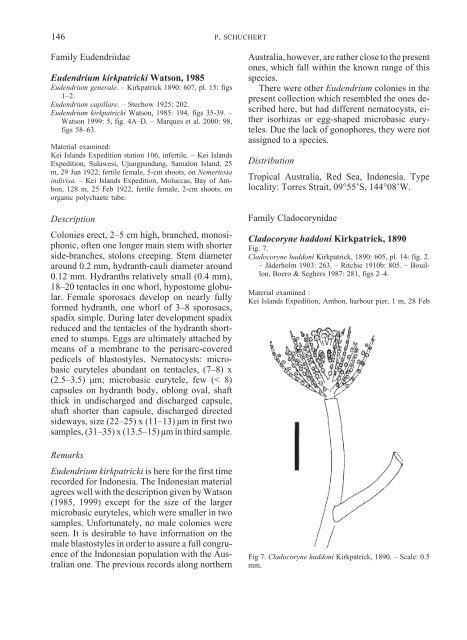Hydroids (Cnidaria, Hydrozoa) of the Danish expedition to
Hydroids (Cnidaria, Hydrozoa) of the Danish expedition to
Hydroids (Cnidaria, Hydrozoa) of the Danish expedition to
You also want an ePaper? Increase the reach of your titles
YUMPU automatically turns print PDFs into web optimized ePapers that Google loves.
146<br />
Family Eudendriidae<br />
Eudendrium kirkpatricki Watson, 1985<br />
Eudendrium generale. – Kirkpatrick 1890: 607, pl. 15: figs<br />
1–2.<br />
Eudendrium capillare. – Stechow 1925: 202.<br />
Eudendrium kirkpatricki Watson, 1985: 194, figs 35-39. –<br />
Watson 1999: 5, fig. 4A–D. – Marques et al. 2000: 98,<br />
figs 58–63.<br />
Material examined:<br />
Kei Islands Expedition station 106, infertile. – Kei Islands<br />
Expedition, Sulawesi, Ujungpandang, Samalon Island, 25<br />
m, 29 Jun 1922, fertile female, 5-cm shoots, on Nemertesia<br />
indivisa. – Kei Islands Expedition, Moluccas, Bay <strong>of</strong> Ambon,<br />
128 m, 25 Feb 1922, fertile female, 2-cm shoots, on<br />
organic polychaete tube.<br />
Description<br />
Colonies erect, 2–5 cm high, branched, monosiphonic,<br />
<strong>of</strong>ten one longer main stem with shorter<br />
side-branches, s<strong>to</strong>lons creeping. Stem diameter<br />
around 0.2 mm, hydranth-cauli diameter around<br />
0.12 mm. Hydranths relatively small (0.4 mm),<br />
18–20 tentacles in one whorl, hypos<strong>to</strong>me globular.<br />
Female sporosacs develop on nearly fully<br />
formed hydranth, one whorl <strong>of</strong> 3–8 sporosacs,<br />
spadix simple. During later development spadix<br />
reduced and <strong>the</strong> tentacles <strong>of</strong> <strong>the</strong> hydranth shortened<br />
<strong>to</strong> stumps. Eggs are ultimately attached by<br />
means <strong>of</strong> a membrane <strong>to</strong> <strong>the</strong> perisarc-covered<br />
pedicels <strong>of</strong> blas<strong>to</strong>styles. Nema<strong>to</strong>cysts: microbasic<br />
euryteles abundant on tentacles, (7–8) x<br />
(2.5–3.5) µm; microbasic eurytele, few (< 8)<br />
capsules on hydranth body, oblong oval, shaft<br />
thick in undischarged and discharged capsule,<br />
shaft shorter than capsule, discharged directed<br />
sideways, size (22–25) x (11–13) µm in first two<br />
samples, (31–35) x (13.5–15) µm in third sample.<br />
Remarks<br />
Eudendrium kirkpatricki is here for <strong>the</strong> first time<br />
recorded for Indonesia. The Indonesian material<br />
agrees well with <strong>the</strong> description given by Watson<br />
(1985, 1999) except for <strong>the</strong> size <strong>of</strong> <strong>the</strong> larger<br />
microbasic euryteles, which were smaller in two<br />
samples. Unfortunately, no male colonies were<br />
seen. It is desirable <strong>to</strong> have information on <strong>the</strong><br />
male blas<strong>to</strong>styles in order <strong>to</strong> assure a full congruence<br />
<strong>of</strong> <strong>the</strong> Indonesian population with <strong>the</strong> Australian<br />
one. The previous records along nor<strong>the</strong>rn<br />
P. SCHUCHERT<br />
Australia, however, are ra<strong>the</strong>r close <strong>to</strong> <strong>the</strong> present<br />
ones, which fall within <strong>the</strong> known range <strong>of</strong> this<br />
species.<br />
There were o<strong>the</strong>r Eudendrium colonies in <strong>the</strong><br />
present collection which resembled <strong>the</strong> ones described<br />
here, but had different nema<strong>to</strong>cysts, ei<strong>the</strong>r<br />
isorhizas or egg-shaped microbasic euryteles.<br />
Due <strong>the</strong> lack <strong>of</strong> gonophores, <strong>the</strong>y were not<br />
assigned <strong>to</strong> a species.<br />
Distribution<br />
Tropical Australia, Red Sea, Indonesia. Type<br />
locality: Torres Strait, 09°55’S, 144°08’W.<br />
Family Cladocorynidae<br />
Cladocoryne haddoni Kirkpatrick, 1890<br />
Fig. 7.<br />
Cladocoryne haddoni Kirkpatrick, 1890: 605, pl. 14: fig. 2.<br />
– Jäderholm 1903: 263. – Ritchie 1910b: 805. – Bouillon,<br />
Boero & Seghers 1987: 281, figs 2–4.<br />
Material examined :<br />
Kei Islands Expedition, Ambon, harbour pier, 1 m, 28 Feb<br />
Fig 7. Cladocoryne haddoni Kirkpatrick, 1890. – Scale: 0.5<br />
mm.

















